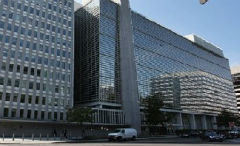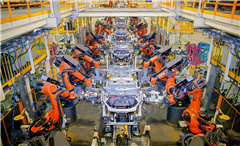China economy 2016: stabilizing and progressing
2017-02-07
chinadaily.com.cn
Despite a sluggish global economy, China’s economy grew by 6.7 percent in 2016, still one of the highest in the world.
The growth of the gross domestic product hit the full year target of about 6.5 percent. The performance in the fourth quarter bucked the trend of decline for the first time in the past two years.
The economy was within a proper range, with improved quality and efficiency, said Ning Jizhe, the chief of the National Bureau of Statistics.
Faced with the slowdown pressure, the Chinese government adopted a set of measures in various fields to improve the economic structure and quality, such as reducing overcapacity, streamlining administrative approvals and boosting innovation to stimulate the economy.
But economists warned that the foundation for steady growth this year remains shaky, as growth of industrial production, fixed-asset investment, inflation-adjusted retail and property sales in the fourth quarter were either slower or flat compared with the previous quarter.
Gross domestic product (GDP)
China’s economy grew 6.7 percent year-on-year to 74.41 trillion yuan ($10.83 trillion) in 2016, the slowest pace of growth in 26 years, but well within the government’s target range of 6.5 to 7 percent.
The service sector accounted for 51.6 percent of GDP in 2016, up 1.4 percentage points year-on-year. The service sector ratio exceeded 50 percent for the first time in 2015.
Value added in the service sector increased 7.8 percent year-on-year to 38.4 trillion yuan, and that in the primary and secondary sectors rose 3.3 percent and 6.1 percent respectively to 6.37 trillion yuan and 29.62 trillion yuan.
Growth in the fourth quarter came in at 6.8 percent, accelerating from the 6.7 percent in the third quarter.
Consumer price index (CPI)
China’s consumer inflation reported faster growth last year, as a price rebound in commodities gradually drove up prices.
The consumer price index (CPI), a main gauge of inflation, rose 2 percent in 2016 —up from 1.4 percent in 2015 —the same rate as 2014. The figure was below the government’s 3-percent target set for the whole year.
In December, the CPI increased 2.1 percent from a year ago, slightly down from November’s 2.3-percent rise.
Sheng Guoqing, senior statistician of the National Bureau of Statistics, attributed December’s slowdown to a high base in the same period of 2015 and weak price increases in vegetables and fruit.
“The inflation data show China’s economy ending 2016 on a strong note,” Bloomberg economist Tom Orlik said. “Consumer price gains edged down, but an increase in the non-food index pointed to resilient demand.”
Orlik also predicts that CPI inflation will continue to edge down over the course of the first quarter as soaring food prices drove the index higher in the same period of 2016.
Producer price index (PPI)
China’s producer price growth beat market expectations in December and surged the most in more than five years supported by rising commodity prices and robust demand.
The producer price index (PPI), which measures costs for goods at the factory gate, rose 5.5 percent year on year in December, the highest reading since September 2011.
The PPI for the whole year dropped 1.4 percent, recovering from a 5.2 percent decline in 2015.
Under pressure from a downturn in the broader economy, the PPI had been trapped in negative territory for 54 months before returning to growth in September. Analysts expect the current rising trend to continue in January.
The better-than-expected increase reinforces views that the world’s second-largest economy continues to show signs of stabilization, adding to hopes that China will gain a firm footing in the start of the new year.
That is also boosting profits for Chinese companies and generating more cash flow to help pay off their loans.
Factors including the exchange rate of the yuan and rising prices of coal and steel led to continuous rises in the PPI, NBS senior statistician Sheng Guoqing said, adding that market demand also saw steady recovery thanks to the ongoing industrial overhaul.
Purchasing managers index (PMI)
The manufacturing Purchasing Managers’ Index (PMI) came in at 51.4 in December, lower than 51.7 in November and staying above the 50-point boom-bust line for the fifth straight month.
The PMI for the whole year averaged at 50.3, compared to 49.9 for 2015.
Despite the slight decline in December, the latest data, the second-highest monthly reading this year, reaffirmed the momentum for a stabilizing Chinese economy, said Zhang Liqun, a researcher with the Development Research Center under the State Council.
A reading above 50 indicates expansion while below 50 suggests contraction.
The sub-index for new orders stayed at the same level as the previous month, the highest point this year. The sub-index for new export and import orders stayed above the boom-bust line of 50 for a second month.
On a quarterly basis, manufacturing PMI had been rising steadily, from the first quarter’s lower than 50 to the second and third quarters’ slightly above 50, and to over 51 for the fourth quarter.
Chen Zhongtao, analyst at the China Logistics Information Center, said positive factors had added up in China’s economic activity, including increasing demand, rising prices, better performance for companies, restructuring and a good job market.
Foreign trade
China’s foreign trade surplus narrowed to 3.35 trillion yuan ($486 billion) in 2016, down 9.1 percent from a year earlier.
The country’s exports in yuan-denominated terms dropped 2 percent to 13.84 trillion yuan year on year in 2016, while imports rose 0.6 percent from the 2015 level to 10.49 trillion yuan.
For the whole year, total export and import value decreased 0.9 percent year on year to 24.33 trillion yuan, narrowing down from a 7 percent decline in 2015.
Huang Songping, spokesperson of the General Administration of Customs, said China faced a “complicated and grim” condition for foreign trade last year with increasing uncertainties and instabilities, but thanks to government efforts, foreign trade has stabilized and started to picking up steam from the second half of 2016.
Huang attributed the trade recovery to supportive policies, a rebound in external demand and a stabilizing domestic economy.
December imports beat forecasts slightly, growing 3.1 percent on its strong demand for commodities which has helped buoy global resources prices, while exports fell by a more-than-expected 6.1 percent on-year.
While the export picture has been grim all year, with shipments rising in only two months out of 12, import trends have been more encouraging of late, pointing to a pick-up in domestic demand as companies brought in more raw materials from iron ore to copper to help feed a construction boom.
China imported record amounts of crude oil, iron ore, copper and soybeans in 2016, plus large volumes of coal used for heating and in steelmaking.
New yuan lending
China’s new yuan-denominated lending beat market estimates to hit 1.04 trillion yuan ($150.29 billion) in December, up from 794.6 billion yuan a month ago.
New yuan-denominated loans for the whole year amounted to a record high of 12.65 trillion yuan, 925.7 billion yuan more than in 2015.
The rise was mainly attributed to lending for home purchases, which surged to 5.68 trillion yuan in 2016 from 3.05 trillion yuan in 2015, although the government rolled out measures to cool the overheated property market.
However, businesses borrowed less. Loans to non-financial enterprises and organizations stood at 6.1 trillion yuan last year, down from 7.38 trillion yuan in 2015.
The M2, a broad measure of money supply that covers cash in circulation and all deposits, rose 11.3 percent year-on-year to 155.01 trillion yuan by the end of December.
The narrow measure of money supply (M1), which covers cash in circulation plus demand deposits, climbed 21.4 percent year-on-year to 48.66 trillion yuan.
The central bank data showed newly added social finance, a gauge of funds that firms and households receive from the financial system, shrank slightly to 1.63 trillion yuan in December.
Industrial output
China’s industrial output expanded 6 percent year-on-year in 2016, largely due to strong performance in the high-tech industry.
Industrial output, officially called industrial value added, is used to measure the activity of designated large enterprises with annual turnover of at least 20 million yuan ($2.9 million).
In December, the total value added of the designated industrial enterprises was up by 6 percent year-on-year, or 0.46 percent every month.
Industrial output in the high-tech industry surged 10.8 percent year-on-year, 4.8 percentage points faster than growth in the secondary industry, accounting for 12.4 percent of the designated industrial enterprises, 0.6 percentage points more than the previous year.
Mining output dropped 1 percent, while manufacturing output increased 6.8 percent. The output for electricity, thermal power, gas and water grew 5.5 percent.
Retail sales
China’s retail sales of consumer goods grew 10.4 percent year-on-year to 33.23 trillion yuan ($4.84 trillion) in 2016.
The growth was 9.6 percent year-on-year after deducting price factors.
In December, the nominal growth of retail sales was 10.9 percent year-on-year, slightly higher than the 10.8 percent increase in November.
Online sales boomed in 2016, surging 26.2 percent year-on-year to reach 5.16 trillion yuan.
Retail sales contributed significantly to China’s economic growth as the country shifts from an export-driven economy to a consumer society.
Retail sales of consumer goods, a key indicator of consumption, are expected to jump by 10.2 percent year-on-year to exceed 37 trillion yuan in 2017, contributing more than 70 percent of the country’s economic growth, according to a report issued by the China General Chamber of Commerce.
Fixed-asset investment
China’s fixed-asset investment grew 8.1 percent year-on-year, down from 10 percent in 2015 and 15.7 percent in 2014.
This indicates continued deceleration of growth in fixed-asset investment: money used to purchase and build factories, machines, property and other fixed facilities.
Fixed-asset investment growth has been declining since reaching an annual high of 10.7 percent for January-March.
In the agricultural sector, fixed-asset investment jumped the fastest, up 21.1 percent year-on-year. It was followed by 10.9 percent growth for the service sector and 3.5 percent for the industrial sector.
Real estate investment
Investment in real estate development grew 6.9 percent year-on-year in 2016, 1.1 percentage points faster than in the first three quarters, and 5.9 percentage points faster than a year earlier.
Factoring in price changes, property investment increased 7.5 percent year-on-year.
For residential properties, investment rose 6.4 percent year on year, and the floor space of new residential construction expanded 8.7 percent year on year.
Property sales jumped 22.5 percent in terms of floor area and 34.8 percent in terms of value.
By the end of December, 695.4 million square meters of property remained unsold in China, down 3.2 percent year on year.
The government has been trying to wean the economy off sizzling property development to make it more sustainable.
The Central Economic Work Conference at the end of last year set the tone for the real estate market in 2017: stable and healthy development.
Personal income
China’s per capita disposable income came to 23,821 yuan ($3,469) in 2016, up 6.3 percent year-on-year in real terms.
Urban and rural per capita disposable income reached 33,616 yuan and 12,363 yuan in 2016, up 5.6 percent and 6.2 percent in real terms, respectively.
The per capita income of urban households was 2.72 times that of rural households.
The average monthly income of rural migrant workers was 3,275 yuan, up by 6.6 percent year-on-year, compared with a 7.2 percent increase in 2015.
China aims to double the per capita income of its urban and rural residents by 2020, from 2010 levels, to build a moderately prosperous society.


